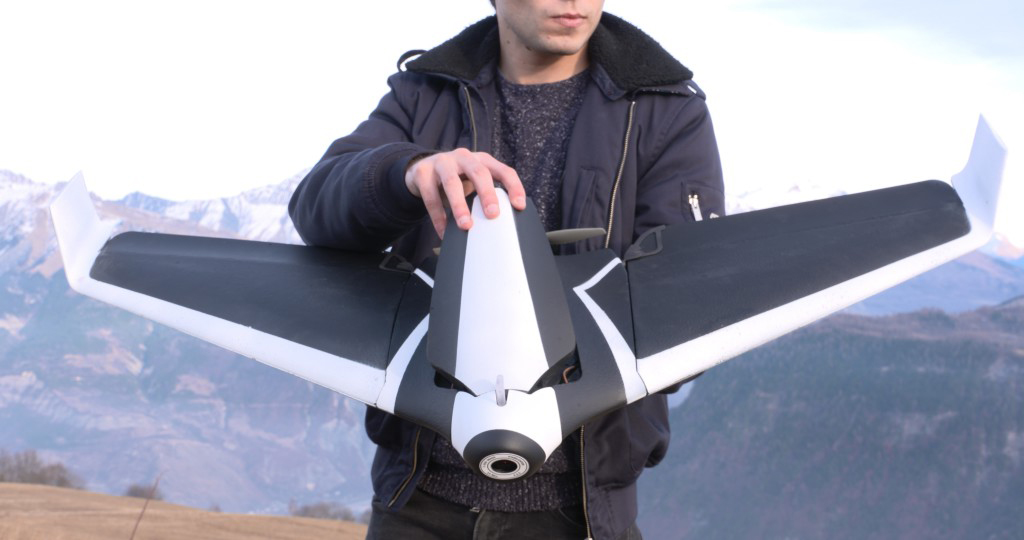Parrot's $1,299 Fixed-Wing Disco Drone Is Ready to Fly
The $1,299 Disco is a fixed wing drone that comes with its own headset for a drone's eye view of where you're flying. It also features an updated controller.

PALM SPRINGS, Calif. — Parrot's fixed-wing Disco drone caught our eye when we spotted it at the Consumer Electronics Show earlier this year. In fact, the Disco turned out to be our favorite drone at the massive trade show. All we were waiting for was word on when Parrot's new drone would arrive and how much it would cost.

Eight months later, the Disco is finally ready to take flight. Parrot says its fixed-wing drone will cost $1,299 — a price tag that not only includes the Disco but also a new version of Parrot's Skycontroller as well as a first-person view headset that will let pilots see things from the Disco's perspective. Parrot Disco ships in September.
MORE: Our Favorite Drones
We knew from the Disco's CES debut that the drone would be able to reach speeds of 50 miles per hour while staying in the air for 45-minute flights. Made from expanded polypropylene and reinforced with carbon tubes, the 22 x 45-inch Disco is fairly lightweight at 1.6 pounds.
In a world full of quadcopters, Parrot's Disco stands out, looking like a slimmed down version of the Stealth Bomber. "It doesn't look like a toy," Parrot CEO Henri Seydoux said at a launch event today (August 23). "It's a modern drone, something out of the 21st century." Though the Disco's wings are fixed, they're also detachable for easy storage.
Parrot promised back in January that the Disco would have the same camera found in its Bebop 2 drone, and indeed, the new device does come with a 14-megapixel full HD frontal camera offering a wide-angle HD view of where you're flying. The camera streams at 720p and you've got 32GB of on-board storage to save your footage.
What's new is the Parrot CockpitGlasses, the FPV headset included with the drone. The CockpitGlasses look a lot like Samsung's Gear VR, in that you insert your smartphone into the glasses. (Parrot has tested a number of phones with the headset, including the iPhone 6 and later, the Nexus 5 and Galaxy S6, among others.) Don the Parrot CockpitGlasses and you'll be able to get a drone's eye view of wherever the Disco flies. Parrot is promising perfectly stable images on its headset, with the effect feeling like you're in the Disco's cockpit.
The Parrot Skycontroller 2 is an updated version of the company's Skycontroller remote. Equipped with a theoretical 1.2-mile reach, this new version of the Skycontroller looks more like something you'd use with a gaming console than a fixed wing drone. The controller features two joysticks that you can move independently to control speed, direction and altitude. It also features customizable direct access and trigger buttons for controlling different aspects of the Disco.
The controller connects to your Android or iOS device via USB through the FreeFlight Pro application. This mobile app gives you control over the altitude and the distance the Disco fly. You can also control video capture via the app and set up a geofence that restricts the flight area for the drone. A Return Home feature lets the Disco fly back to where it took off from, using GPS to pinpoint the location. Parrot will sell a Flight Plan feature as a $20 in-app purchase if you want to plot out a course for your phone.
The app captures all your flight information, include the trajectory of your flight and stats like speed and altitude. You can then upload that information to the cloud.
Get instant access to breaking news, the hottest reviews, great deals and helpful tips.
Launching the Disco into the air is a matter of pushing a switch located on the drone's nose and using the Skycontroller 2's takeoff/landing button. From there, you toss the drone into the air just like you would a Frisbee. The Disco automatically ascends to 164 feet and circles at that altitude until you're ready to fly the drone. When it's time to land — again, you press that takeoff/landing button on the Skycontroller — the drone descends, using information from its altimeter, ultrasound sensor and vertical camera to reduce engine speed and land in a straight line.
Helping with these assisted flight features is the Parrot Control Hub and Universal Computer Kit, or CHUCK. The system uses sensors and algorithms to handle tasks like adjusting for pitch and keeping the Disco stable. Advanced pilots can connect the Disco to an RC if they want to fly without any autopilot assistance.
A brushless engine with a folding bi-blades propeller powers the Disco. "It is not possible to make a product with less mechanical parts than this one," Seydoux said.
We're at Parrot's launch event for the Disco here in the California desert, and we should be able to get our hands on the drone later today. We'll let you know just what you can expect from the Disco once we get the chance to take the drone out for a flight ourselves.
Philip Michaels is a Managing Editor at Tom's Guide. He's been covering personal technology since 1999 and was in the building when Steve Jobs showed off the iPhone for the first time. He's been evaluating smartphones since that first iPhone debuted in 2007, and he's been following phone carriers and smartphone plans since 2015. He has strong opinions about Apple, the Oakland Athletics, old movies and proper butchery techniques. Follow him at @PhilipMichaels.

